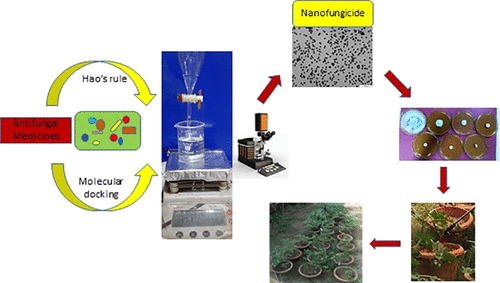当前位置:
X-MOL 学术
›
J. Agric. Food Chem.
›
论文详情
Our official English website, www.x-mol.net, welcomes your feedback! (Note: you will need to create a separate account there.)
Preparation of Nanofungicides Based on Imidazole Drugs and Their Antifungal Evaluation.
Journal of Agricultural and Food Chemistry ( IF 6.1 ) Pub Date : 2020-04-13 , DOI: 10.1021/acs.jafc.9b06387 Madhu Tippannanavar 1 , Ankita Verma 1 , Rajesh Kumar 1 , Robin Gogoi 2 , Aditi Kundu 1 , Neeraj Patanjali 1
Journal of Agricultural and Food Chemistry ( IF 6.1 ) Pub Date : 2020-04-13 , DOI: 10.1021/acs.jafc.9b06387 Madhu Tippannanavar 1 , Ankita Verma 1 , Rajesh Kumar 1 , Robin Gogoi 2 , Aditi Kundu 1 , Neeraj Patanjali 1
Affiliation

|
In spite of modern crop protection measures, the overall crop losses due to pests and pathogens are huge. Rhizoctonia solani, Macrophomina phaseolina, Sclerotium rolfsii, and Fusarium oxysporum are one of the most devastating soil-borne fungi and cause numerous plant diseases. Therefore, the present study aimed to systematically design and develop new nanofungicides based on imidazole drugs, clotrimazole, econazole nitrate, and miconazole nitrate, for effective and efficient management of plant diseases. The assessment of these antifungal medicines for their fungicide likeness using Hao's rule and their enzyme inhibitory potential by molecular docking was helpful in ensuring their utility as antifungal agents in managing phytopathogenic fungi. Nanotechnological strategies were used to develop nanoformulations of test compounds in poly(ethylene glycol) 300 for further augmenting their bioactivity. Transmission electron microscopy studies confirmed the nanosize of the prepared products. Analysis of their in vitro and in vivo antifungal properties revealed their usefulness in controlling the test fungi, R. solani, M. phaseolina, S. rolfsii, and F. oxysporum. Excellent in vitro antifungal activities were displayed by the clotrimazole nanoformulation with a median effective dose (ED50) of 1.18 μg/mL against R. solani, the econazole nitrate nanoformulation with an ED50 of 5.25 μg/mL against S. rolfsii, and the miconazole nitrate nanoformulation with an ED50 of 1.49 and 1.82 μg/mL against M. phaseolina and F. oxysporum. Furthermore, in vivo studies against test fungi demonstrated the antifungal potency of all the nanoformulations with disease incidences ranging from 11.11 to 27.38% in plants treated with nanoformulations of test chemicals as compared to the inoculated control (39.68-72.38%).
中文翻译:

基于咪唑类药物的纳米杀菌剂的制备及其抗真菌评价。
尽管采取了现代作物保护措施,但由于病虫和病原体造成的总体作物损失仍然巨大。茄状枯萎病菌,菜豆大环孢菌,罗氏菌菌和尖孢镰刀菌是最具破坏性的土壤传播真菌之一,并引起多种植物病害。因此,本研究旨在系统地设计和开发基于咪唑药物,克霉唑,硝酸益康唑和硝酸咪康唑的新型纳米杀菌剂,以有效地管理植物病害。使用郝氏定律评估这些抗真菌药物的杀真菌剂相似性,并通过分子对接评估它们的酶抑制潜力,有助于确保它们作为抗真菌剂在控制植物病原真菌中的应用。纳米技术策略被用于开发聚(乙二醇)300中测试化合物的纳米制剂,以进一步增强其生物活性。透射电子显微镜研究证实了所制备产品的纳米尺寸。对它们的体外和体内抗真菌特性的分析表明,它们在控制测试真菌,R。solani,M。phaseolina,S。rolfsii和F. oxysporum中有用。克霉唑纳米制剂对雷氏梭菌的平均有效剂量(ED50)为1.18μg/ mL,硝酸益康唑硝酸盐纳米制剂对罗非鱼的ED50为5.25μg/ mL和硝酸咪康唑具有出色的体外抗真菌活性。相对于菜豆分枝杆菌和尖孢镰刀菌的ED50为1.49和1.82μg/ mL的纳米制剂。此外,
更新日期:2020-04-24
中文翻译:

基于咪唑类药物的纳米杀菌剂的制备及其抗真菌评价。
尽管采取了现代作物保护措施,但由于病虫和病原体造成的总体作物损失仍然巨大。茄状枯萎病菌,菜豆大环孢菌,罗氏菌菌和尖孢镰刀菌是最具破坏性的土壤传播真菌之一,并引起多种植物病害。因此,本研究旨在系统地设计和开发基于咪唑药物,克霉唑,硝酸益康唑和硝酸咪康唑的新型纳米杀菌剂,以有效地管理植物病害。使用郝氏定律评估这些抗真菌药物的杀真菌剂相似性,并通过分子对接评估它们的酶抑制潜力,有助于确保它们作为抗真菌剂在控制植物病原真菌中的应用。纳米技术策略被用于开发聚(乙二醇)300中测试化合物的纳米制剂,以进一步增强其生物活性。透射电子显微镜研究证实了所制备产品的纳米尺寸。对它们的体外和体内抗真菌特性的分析表明,它们在控制测试真菌,R。solani,M。phaseolina,S。rolfsii和F. oxysporum中有用。克霉唑纳米制剂对雷氏梭菌的平均有效剂量(ED50)为1.18μg/ mL,硝酸益康唑硝酸盐纳米制剂对罗非鱼的ED50为5.25μg/ mL和硝酸咪康唑具有出色的体外抗真菌活性。相对于菜豆分枝杆菌和尖孢镰刀菌的ED50为1.49和1.82μg/ mL的纳米制剂。此外,



























 京公网安备 11010802027423号
京公网安备 11010802027423号